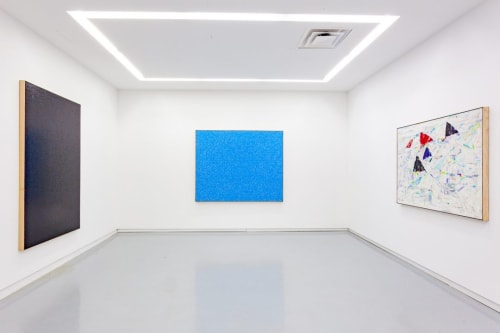Thirty-five years ago, Young-Il Ahn (b. 1934) had a disturbing experience while fishing off the coast of California. A dense fog had rolled in and for a few hours, his small boat aimlessly bobbled on the surface of the sea. Many kinds of unexpected events may leave one disoriented, and eventually, most of us move on. This one, however, continues to inspire the artist to express what he felt, and so far, there are nearly four hundred paintings in a series called “Water.” From across the room, each piece is not much to look at—just a monotone rectangle in blue, white, gray or black. Up close, however, the surface is humming with activity. This is not a depiction of water as it heaves, sprays or splashes. Nor does it share that especially East Asian fascination with how water flows, as depicted so succinctly by Young’s Korean contemporary, Lee Ufan.
In Young’s paintings, the water just sits there in a strict orthogonal grid: quivering, infinite, undifferentiated and quietly alarming. There is no escape. Your life is insignificant. You’ve become immersed in a story about the physical properties of water, where nothing has changed since the universe began.
Some pieces don’t offer much more variation than might be found within the grid of a coarsely woven canvas. Why not just stretch it and leave it unpainted? In most pieces, however, the artist offers a larger pattern of subtle variations in texture or perks it up with tiny dabs of strong color. Rather than the anxiety of being lost at sea, I feel the peaceful calm of a meditative mind whirling away—alive but not very engaged.
More stimulation can be found in the several other series of paintings on which the artist has been concurrently working: “California,” “Sunset,” “Musicians” and “Birds.” As these names might suggest, this work is more lighthearted, possibly aimed at a broader audience, beyond the sanctified chapels of contemporary art. The bright, busy surfaces remind me of the sports illustration of LeRoy Neiman—there’s such a happy, superficial intensity about them. The more figurative pieces depicting musicians or birds are disappointing.
The figures are awkward and the designs are cluttered. The cityscape of a California harbor, however, offers a delightful urban and graphic intensity. Most delightful of all is the celestial shower of colorful shapes called “Sunset at Lake Isabella.” Paint has been applied in almost every possible way: stained, soaked, smudged, dripped, troweled or dabbed.
Not every painting is lighthearted. There are three solemn, even horrific memorials to 9/11, painted soon thereafter. Ugly splotches of black paint express the hatefulness and destruction of the attack and the emptiness of its aftermath. One painting depicts the American flag, shot through with black holes, but still intact, and still quite vibrant. It appears that this immigrant from Kaesong (now part of North Korea) identifies strongly with his new nationality and he’s proud to show it.
The closer a painting sticks to an evenly spaced, orthogonal grid, the more it might represent a life that surrenders to rules and routine rather than risking confrontation and change. The more the grid is loosened, the more it might represent a life more open to new experience. Both kinds of paintings fill the floors of Kavi Gupta’s spacious Elizabeth Street gallery. The more time you spend with it, the more you seem to personally know this quiet, sensitive resilient soul who so loves painting, classical music and those places in the world where land meets water.

